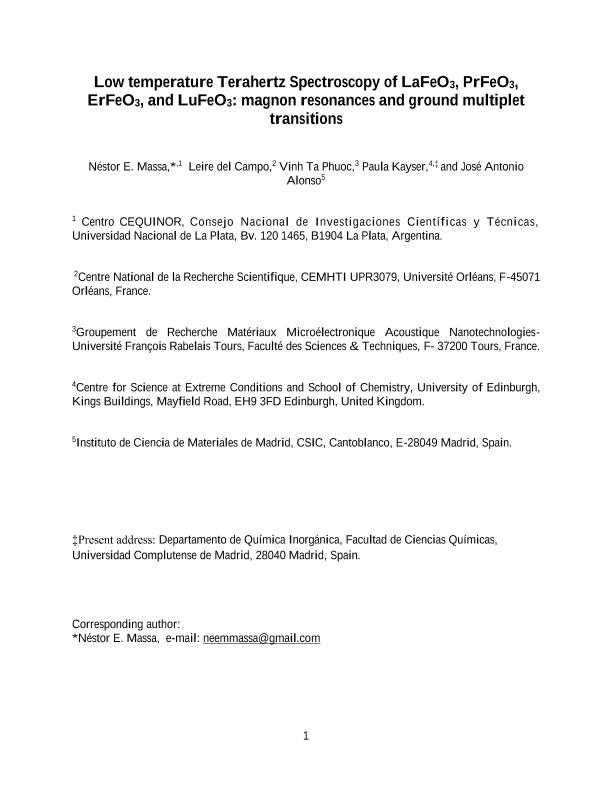Artículo
Low-temperature terahertz spectroscopy of LaFeO3, PrFeO3, ErFeO3, and LuFeO3: Quasimagnon resonances and ground-state multiplet transitions
Fecha de publicación:
02/2023
Editorial:
American Physical Society
Revista:
Physical Review B
ISSN:
2331-8422
e-ISSN:
2331-8422
Idioma:
Inglés
Tipo de recurso:
Artículo publicado
Clasificación temática:
Resumen
We report on zone center THz excitations of non--Jahn Teller LaFeO3, PrFeO3, ErFeO3, and LuFeO3 distorted perovskites under external magnetic fields up 7 T. Our measurements on low temperature-low energy absorptions of LaFeO3 show antiferromagnetic and ferromagnetic magnons at ωAFM~31.4 and ωFM ~26.7 cm-1 in the Γ4 (Gx, Ay, Fz) representation with degeneracy near linearly lifted by the field. LuFeO3 is characterized by zero field magnetic resonances at ωAFM ~26.3 cm-1 and ωFM ~22.4 cm-1 in addition to Fe3+ Zeeman -split crystal field (CF) 6A1 ground transitions at ~10.4 cm-1 triggered by subtle structural deviations induced by the Lu 4f14 smaller ionic radius at the A site. This local quasi-non-centrosymmetric departure is also found in ErFeO3 (Kramers 4f11 Er3+ (4I15/2); Γ2 (Fx, Cy, Gz) <TSR ~93 K), but with the ~4 cm-1 Fe3+ Zeeman branching strongly biased toward higher energies due to 3d-4f exchange. Magnons at ωAFM ~31.5 cm-1 and ωFM ~21.5 cm-1 in ErFeO3 do not undergo field induced band splits but a 13-fold increase in the antiferro (ωAMF) /ferro(ωAFM) intensity ratio. There is a remarkable field-dependent CF matching population balance between Fe3+ higher and Er3+ lower Zeeman branches. The Er3+ (4I15/2) multiplet, at the 49.5 cm-1, 110.5 cm-1, and 167.3 cm-1, coincides with external lattice mode frequencies suggesting strong lattice driven spin-phonon interactions. Far infrared absorption ratios under mild external fields reveal magnetic dependence only for those zone center phonons involving moving magnetic ions. Antiferro- and ferro- resonances in PrFeO3 turn much broader as non-Kramers Pr3 introduces ligand changes at the A site leading into near degeneracy the antiferromagnetic mode and the lowest Pr3+ CF transition. They merge into a single broad mostly unresolved feature at 7 T. We conclude that low energy excitations in RFeO3 (R=rare earth) strongly depend on the lanthanide ionic size thus indivisibly tied to the mechanism associated to the origin of canted ferromagnetism. In addition, minute lattice displacements also underlie considering noncentrosymmetric the most distorted RFeO3 (R=rare earth). In these perovskites the changes triggered in the lattice by the smaller rare earth and the nonlinear intrinsic oxygen ion polarizability, known to drive lattice instabilities, provide grounds for interplay of ionic and electronic interactions yielding ferroelectric spontaneous polarization.
Archivos asociados
Licencia
Identificadores
Colecciones
Articulos(CEQUINOR)
Articulos de CENTRO DE QUIMICA INORGANICA "DR. PEDRO J. AYMONINO"
Articulos de CENTRO DE QUIMICA INORGANICA "DR. PEDRO J. AYMONINO"
Citación
Massa, Nestor Emilio; Del Campo, Leire; Ta Phuoc, Vinh; Kayser, Paula; Alonso, José Antonio; Low-temperature terahertz spectroscopy of LaFeO3, PrFeO3, ErFeO3, and LuFeO3: Quasimagnon resonances and ground-state multiplet transitions; American Physical Society; Physical Review B; 108; 11; 2-2023; 1-70
Compartir
Altmétricas




